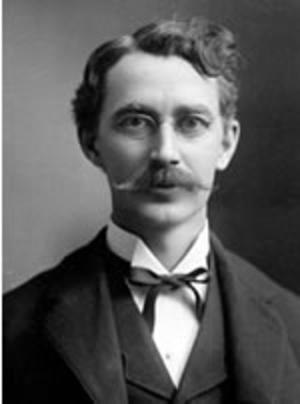
Arthur W. Palmer was born in London, England in 1861. He obtained a BS in chemistry at the University of Illinois in 1883 and an ScD in chemistry from Harvard in 1886. He then spent a year in Germany, studying first with Victor Meyer and then with August Hofmann. While in Berlin with Hofmann he began his work on arsines, which culminated three years later, after his return to the University of Illinois, in the establishment if the existence of that series which to date had been described as not existing. Dr. Palmer was called back to Illinois in 1889 and returned there in September of that year as an assistant professor of chemistry.
In 1895, a special appropriation of the Illinois State Legislature established the State Water Survey "for carrying on a systematic survey of the waters of the state." The work was started under Dr. Palmer's direction with the help of a full-time assistant. This work, as well as the growing work of the Department of Chemistry, was going forward quite well, when on the early morning of August 15, 1896, the Chemistry Laboratory (now Harker Hall) was struck by lightning. The entire upper floor was burned, as was a large portion of the second floor. Thus began a four year fight to convince the State Legislature to fund a new Chemical Laboratory.
The importance of this funding can be best described by Dean Eugene Davenport during the Memorial Service for Prof. Palmer:
A decade ago the department enjoyed an enviable reputation. Its fame was not limited to the natural constituency of this University, but it was widely and favorably known among universities everywhere, and it did not seem too much to look forward to the time when it should occupy front rank among the leading departments of chemistry in the country.
Then came the burning of the chemical building. Because of scarcity of funds, and because a new and more commodious structure was to be asked for, the laboratories were never completely restored. The ruin was roofed over, and the work reinstalled, but in a temporary and exceedingly inadequate manner. The building needed was not provided, and for four years this department marked time and struggled for existence.
This condition of things was at the threshold of the greatest period of general growth ever experienced by the University. Students rapidly increased in numbers in all the colleges, and the old laboratories already overcrowded were flooded beyond their capacity with students seeking elementary instruction. Here for more than four years the resources of the department were taxed to the utmost to meet the increasing demands on the part of the University for elementary chemistry. General prosperity was a fact, but it brought about conditions doubly hard upon this department laboring to sustain its reputation among more fortunate neighbors in other institutions.
Then came the final struggle when the building was won; though the amount granted was insufficient, and those who knew Professor Palmer in those dark days when the chemical building for the third time hung in the balance - those only knew what the issue meant to him.
And from Professor L. P. Breckenridge at that same Memorial Service:
Here at Illinois has fortunately been completed a perpetual memorial to him who has gone. We are glad that he lived to see his cherished plans in brick and mortar finished. I shall always remember the beaming and delighted expression of his face when the money for the Chemical Laboratory [Noyes Laboratory] was really appropriated. "It hardly seems possible that it is true," he said. And then how he worked building his laboratory, watching every detail by day, and while the laborers slept he planned and thought by night. . . . What we say here today will soon be forgotten, but many things that he did will endure for years to come. He taught the science of chemistry to many students. It seems to me that this was his greatest work. He contributed to the fund of knowledge in the realm of chemical science. He served the people of Illinois by the application of his science to the needs, comforts, the very life of her citizens. He built the Chemical Laboratory. These were his public services.
It was commonly accepted that Professor Palmer died of overwork. His lasting monuments are the Illinois State Water Survey and Noyes Laboratory.
- University of Illinois Bulletin: University of Illinois Circular of Information of the Department of Chemistry XIII (25), February 21, 1916, 16-44.
- University of Illinois Memorial Convocation for Professor Arthur W. Palmer. February 7, 1904.
- Elliott, C. A. Biographical Dictionary of American Science, Greenwood Press: 1979; p198.